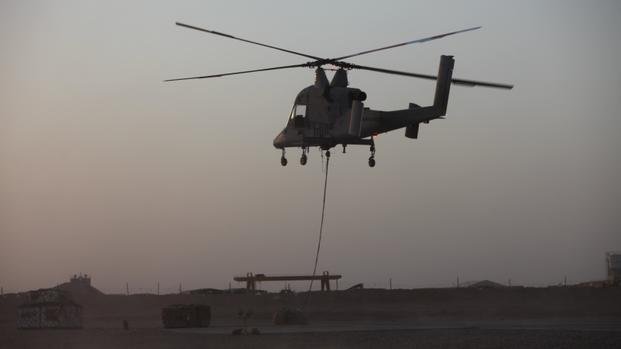Two remotely piloted helicopters that spent three years moving gear for Marines in Afghanistan are now undergoing tests and experiments that could take their role even further.
The K-MAX helicopters made by Lockheed Martin Corp. and Kaman Corp. arrived May 8 at the Marine Corps’ Operational Test & Evaluation Squadron 22 at Marine Corps Air Station Yuma, Arizona, where they will be used to further the Corps’ experiments with payloads, sensors and other cutting-edge aviation technology.
The 6,000-pound K-MAX is unique in that it can carry loads totaling its own weight, and can fly with or without a pilot on board. That cargo-lift capability could prove an asset for intelligence, surveillance and reconnaissanceactivities, allowing Marines to put larger payloads aboard the aircraft than they can with more commonly used unmanned aerial vehicles.
“That’s one of the attractive things about the platform,” Maj. James Compton, unmanned aircraft systems cell lead for Headquarters Marine Corps Aviation, told Military.com. “[RQ-7] Shadows and [RQ-21] Blackjack simply can’t carry stuff of the size that the K-MAX can.”
The two aircraft owned by by the Marine Corps were used to move gear and dismantle forward operating bases in Afghanistan before returning to a storage facility in Owego, New York, for reset in 2014. One of the $14 million aircraft had been significantly damaged during a hard landing, and needed extensive repairs.
In the process, Lockheed Martin officials added some modifications that make it even more capable: an MX-10 tactical surveillance camera, and a high-bandwidth datalink that allows the aircraft to transmit real-time information to operators on the ground.
“We did cargo flawlessly. But now we’re beginning to say, ‘what can it do beyond that?’” John McMillan, Lockheed’s business development lead for the K-MAX, told Military.com. “One of the things you get into with rotorcraft is, a lot of times they’re very expensive to operate. This was designed with a commercial mindset. It is the cheapest platform to operate in its class.”
More modifications may be on the way.
Compton said officials are eager to experiment with mounting a weapons system on the K-MAX, likely the Advanced Precision Kill Weapons System 70mm laser-guided rocket system from BAE Systems Plc.
For now, however, the Marines are taking advantage of the opportunity to put the aircraft through its paces and experiment with a variety of payloads and sensors. Compton said the option of putting a “safety pilot” on board enabled the squadron to try “new and novel” things without risking a crash.
“We’re keeping it very open ended,” he said. “We own [the K-MAX aircraft]; it makes sense to keep them flying. It’s got a lot of growth capability in terms of what they can carry--different tactics, techniques and procedures, and interesting ideas as they emerge from industry.”
For now, four Marines are being trained to operate the K-MAX, which is remotely piloted using a controller remarkably similar to that used for Playstation 2 video games. The aircraft will likely be integrated into the twice-annual Weapons and Tactics Instructor course that also takes place at Yuma, Compton said, though it’s not clear if other exercises will be added to the schedule.
The K-MAX is not a program of record for the Marine Corps, and a decision still had not been made regarding whether to purchase more of the aircraft, Compton said. Right now, the Marine Corps is developing a requirement for a [Marine Corps Air-Ground Task Force] Expeditionary unmanned aircraft system, he said, which will involve a cargo lift capability.
“That helps to solidify and identify this is an enduring requirement for the Marine Corps,” he said.









